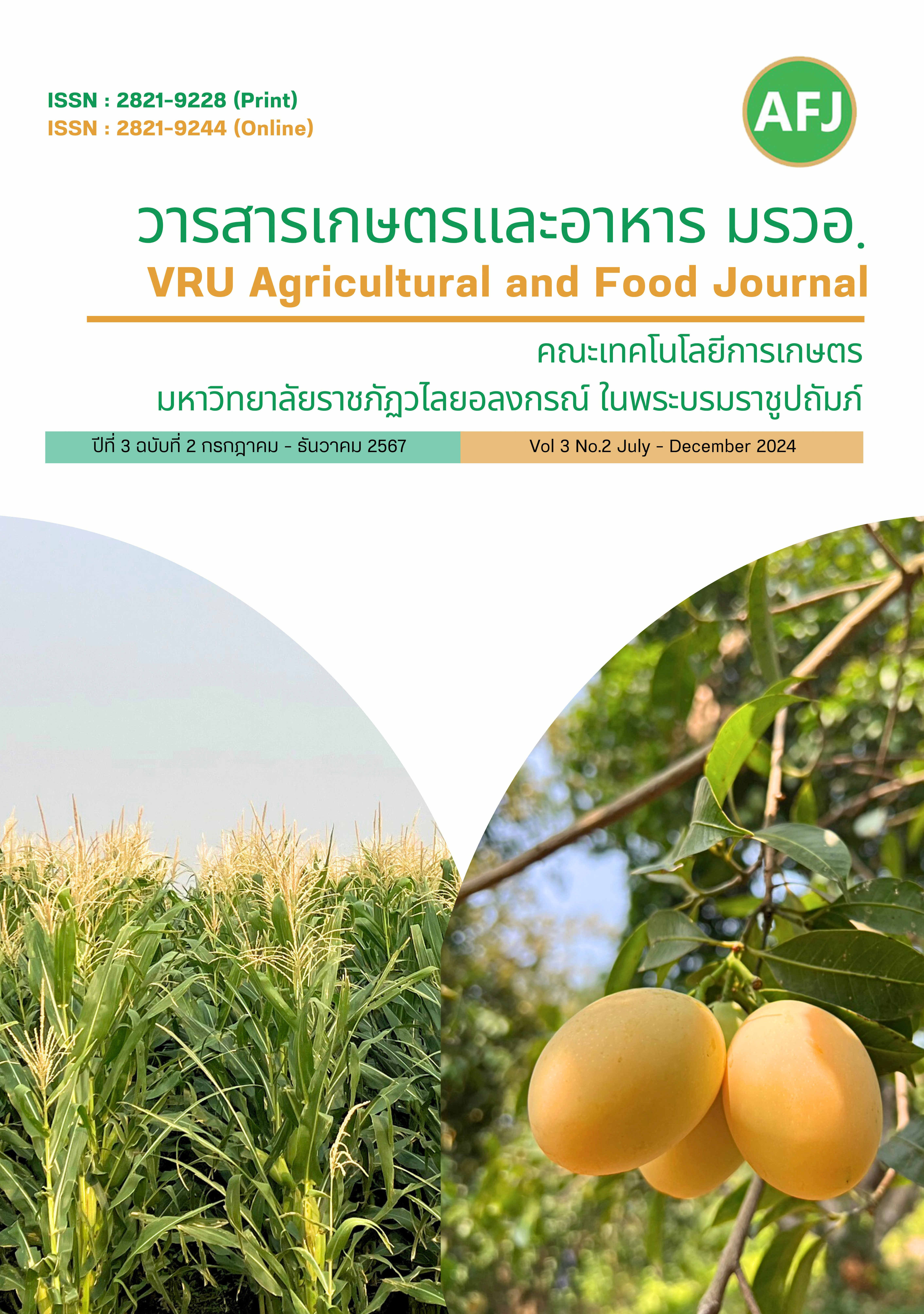อิทธิพลของระยะปลูกและอัตราปุ๋ยที่มีต่อการเจริญเติบโตและผลผลิตของถั่วหรั่งสายพันธุ์ใหม่
Main Article Content
บทคัดย่อ
งานวิจัยนี้เป็นการศึกษาวิธีการเขตกรรมที่เหมาะสมสำหรับถั่วหรั่งสายพันธุ์ 23-1C-2-2 มีวัตถุประสงค์เพื่อศึกษาระยะปลูกและอัตราปุ๋ยที่เหมาะสมกับถั่วหรั่งสายพันธุ์ดีเด่น 23-1C-2-2 สำหรับใช้เป็นคำแนะนำให้แก่เกษตรกรและใช้เป็นข้อมูลเพื่อการขอรับรองพันธุ์ จัดการทดลองแบบ 3 x 3 Factorial in RCBD มี 9 กรรมวิธี 4 ซ้ำโดยปัจจัยที่ 1 คือ ระยะปลูก 3 ระยะ ได้แก่ 40 x 40, 50 x 50 และ 60 x 60 ซม. ปัจจัยที่ 2 คือ การใส่ปุ๋ยที่แตกต่างกัน 3 อัตรา ได้แก่ 0.5, 1.0 และ 1.5 เท่าของอัตราแนะนำ (โดยมีอัตราแนะนำเท่ากับ 3-9-6 กก./ไร่ ของ N-P2O5–K2O) ทำการทดลองในฤดูฝน ปี 2565 ที่ศูนย์วิจัยพืชไร่สงขลา ผลการศึกษา พบว่า ระยะปลูกและอัตราปุ๋ยไม่มีปฏิสัมพันธ์ร่วมกันที่มีผลต่อการเจริญเติบโต ผลผลิตและองค์ประกอบของผลผลิตในถั่วหรั่งสายพันธุ์ดีเด่น 23-1C-2-2 การใช้ระยะปลูก 60 x 60 ซม. ส่งผลให้ถั่วหรั่งมีขนาดทรงพุ่มกว้างที่สุดเฉลี่ย 50.84 ซม. ขณะที่การปลูกระยะ 40 x 40 ซม. ให้ผลผลิตฝักสดและฝักแห้งสูงสุดเฉลี่ย 422 และ 123 กก./ไร่ ตามลำดับ การใส่ปุ๋ยทั้ง 3 อัตราให้ผลผลิตฝักสดและฝักแห้งไม่แตกต่างกัน โดยผลผลิตฝักสดเฉลี่ยระหว่าง 309-328 กก./ไร่ และผลผลิตฝักแห้งเฉลี่ยระหว่าง 91-94 กก./ไร่ นอกจากนี้การใช้ระยะปลูก 40 x40 ซม. ยังส่งผลให้มีเปอร์เซ็นต์กะเทาะสูงสุดเฉลี่ย 66.91 % ดังนั้นควรปลูกถั่วหรั่งสายพันธุ์ 23-1C-2-2 ที่ระยะปลูก 40x40 ซม. และใช้ปุ๋ย 1.5-4.5-3 กก./ไร่ ของ N-P2O5 –K2O เนื่องจากให้ผลผลิตฝักสดและผลผลิตฝักแห้งไม่แตกต่างกันทางสถิติ และเป็นการลดต้นทุนจากการใช้ปุ๋ยในการผลิตถั่วหรั่ง
Article Details

อนุญาตภายใต้เงื่อนไข Creative Commons Attribution-NonCommercial-NoDerivatives 4.0 International License.
บทความนี้ได้รับการเผยแพร่ภายใต้สัญญาอนุญาต Creative Commons Attribution-NonCommercial-NoDerivatives 4.0 International (CC BY-NC-ND 4.0) ซึ่งอนุญาตให้ผู้อื่นสามารถแชร์บทความได้โดยให้เครดิตผู้เขียนและห้ามนำไปใช้เพื่อการค้าหรือดัดแปลง หากต้องการใช้งานซ้ำในลักษณะอื่น ๆ หรือการเผยแพร่ซ้ำ จำเป็นต้องได้รับอนุญาตจากวารสารเอกสารอ้างอิง
Adeyeye, A.S., A.E. Dimas, K.K. Olalekan, W.A. Lamidi, H.J. Othman and M.A. Ishaku. 2019. The Effect of organic and inorganic nutrient sources on the growth and seed yield of Bambara Nut (Vigna Subterranean (L) Verdc) Variety. World Journal of Agriculture and Soil Science. 2(3): 1-9.
Akpalu, M. M., J. Sarkodie-Addo and S. E. Akpalu. 2012. Effect of Spacing on Growth and Yield of Five Bambara Groundnut (Vigna Subterranea (L) Verdc.) Landraces. Journal of Science and Technology. 32(2): 9-19.
Alhassan, G.A., B.A. Kalu and O.M. Egbe. 2012. Influence of planting densities on the performance of intercropped Bamabra groundnut with Cowpea in Makurdi Benue State Nigeria. International Journal of Development and Sustainability. 1(3) 860-879.
Chotechuang, S., S. Boonratsamee, S. Jongthitinon, P. Kinnaret, S. Rachanuch, J. Rodthuk, A. Kongisaro, N. Chusinuan, S. Phaoblek, C. Kongnakorn and J. Suwanprasert. 2023. Farmer fields yield trials : Bambara groundnut lines derived from series 2008-2009 crosses. Khon Kaen Agriculture Joural. 51(2): 149-156. (in Thai)
Department of Agriculture. 2021. Recommendations for using fertilizers for economic crops. Agricultural Production science Research and Development Division, Department of Agriculture. 1-100. (in Thai)
Effa, E.B., F.A. Nwagwu, E.O. Osai and J.O. Shiyam. 2019. Growth and yield response of Bambara groundnut (Vigna subterranea (L.) Verdc) to varying densities and Phosphate fertilizer rates in Calabar, South Eastern Nigeria. Journal of Biology Agriculture and Healthcare. 6: 14 - 20.
Gomez, K.A., and A.A. Gomez. 1984. Statistical Procedures for Agricultural Research 2nd Ed. John Wiley & Sons.
Jonah, P.M., O.T.Adeniji and D.T. Wammanda. 2010. Genetic correlations and path analysis in bambara groundnut (Vigna subterranea). Journal of Agriculture & Social Sciences. 6: 1-5.
Kongkham, K. 2007. Responses of peanut to soil improvement by organic fertilizer and Gypsum. Suthep sub-district, mung district Chiang Mai province. MS Thesis, Chiang Mai University. (in Thai)
Kwankaew, T. and A. Chumthong. 2018. Effect of plant spacing on growth yield and yield components of bambara groundnut cultivar Songkhla 1. Thai Science and Technology Journal. 28(2): 322 - 330. (in Thai)
Mkandiwire, F.L. and K. P. Sibuga. 2002. Yield Response of Bambara Groundnut to Plant Population and Seedbed Type. Africa Crop Science Journal. 10: 39 – 49.
Obidiebube, E., S. Akparobi, P. Erutor, and U. Achebe. 2019. Effect of spacings on the growth and yield of Bambara groundnut (Vigna Subterrananea (L) Verdc.) in Asaba Delta State. Global Journal of Agricultural Research. 7(3): 9 - 13.
Saetan, J. and W, Krianyakul. 1987. Preliminary study on botanical characteristics planting method yield of bambara groundnut. In Proc. 12th Plant Sciences Kasetsart University, 3 - 6 February 1987. 225-231. (in Thai)
Srisaengchan, S., P. Wisetsin and S. Wisarthaphong. 1998. Production and marketing conditions of bambara groundnut by farmers in the southern region. Department of Agricultural Extension. 1-78. (in Thai)
Swanevelder, C.J. 1998. Bambara food for Africa (Vigna subterranea). National Department of Agriculture Republic of South Africa. 1-66.
Tyoakoso, M. M., B. B. Jakusko and M. Anayib. 2019. Effects of Nitrogen rate on growth and yield of Bambara groundnut (Vigna sunterranea (L.) Verdc,) in Jalingo, Taraba State. International Journal of Research Granthaalayah. 7(12): 67-76.
Yusuf, A. A., H. Ayedun and L. Sanni. 2008. Chemical composition and functional properties of raw and roasted Nigerian benniseed (Sesamum indicum) and Bambara groundnut (Vigna subterranea). Food Chemistry. 111(2):277-282.


